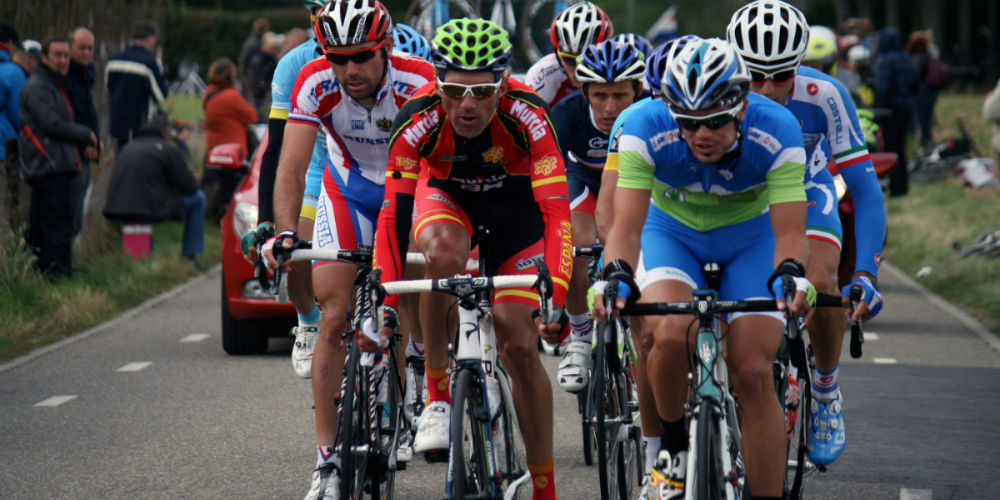Lessons from the Men’s Olympic cycling road race

The 2016 Olympic cycling road race – a punishing, 148-mile course through the hills and along the coast in Rio, featuring 11 climbs with gradients in excess of 24% – witnessed numerous crashes on the dangerous descents that led to an unexpected outcome, as Belgium’s Greg Van Avermaet became the first gold medalist from his country since 1952. The race also provided some important insights regarding risk-taking, strategy and successfully competing.
Know Your Limits
From the start, there was no clear winner in this race. While Van Avermaet and France’s Julian Alaphilippe were among Cyclingnews’ “Ten Riders to Watch” in this year’s event, none of the other top-ten finishers were from that list. Alaphilippe placed just outside medal contention in fourth. Oddsmakers gave little consideration to the possibility of Van Avermaet winning gold.
The course started out flat along the coast outside of Rio for nearly 30 miles before facing four loops around a tough circuit that featured a set of cobblestones, and two short, but brutally steep climbs. That section began to splinter the field, before a turn back along the same coastal road to the major test of the day.
The final circuit, representing the penultimate section of the route, was comprised of three loops through a heavy canopy of trees, with a relentless 2000-foot climb of the Vista Chinesa, at a maximum gradient of nearly 20%. This section would ultimately determine the outcome of the race, but not in the way one would expect: such courses typically destroy the field by way of a blistering pace set by the top climbers. While that did occur, it didn’t determine the ultimate outcome.
Following the third time up the grueling Chinesa, the riders had to descend back to sea level, dropping 2000 feet in a scant two miles before the flat, three-mile run to the finish line. It was that final descent that decided the race.
At the summit of the climb, a three-man group of Italy’s Vincenzo Nibali, Colombia’s Sergio Henao, and Poland’s Rafal Majka broke away on the harrowing descent. Nibali, known for his aggressive descending style and superb bike-handling skills, threw caution to the wind, putting his fellow leaders (and those behind) on the limit, taking one hairpin turn after another at speeds in excess of 50 mph. It appeared the Italian was destined for Olympic glory.
However, Nibali took one risk too many, and crashed spectacularly into a guardrail on a switchback with less than seven miles to the finish, taking Henao down with him. Majka carefully navigated the carnage on the road to continue flying down the mountain alone. (Note: this same descent would see a horrific crash in the women’s road race that left the rider with a concussion and three spinal fractures.)
Work Together
Now it appeared Majka’s opportunity to claim gold for Poland for the first time in Olympic history. The chasing group of about seven riders, only 20 seconds in arrears of Majka at the foot of the descent, refused to work together to catch the leader. Unwilling to merely settle for silver or bronze, Van Avermaet and Denmark’s Jacob Fuglsgang broke away, chasing Majka down with just over a mile to go.
At that point, the race was all but decided, as Van Avermaet is the strongest sprinter of the trio, at least on paper. The Belgian lived up to that reputation, out-sprinting Fuglsgang on the line, with Majka claiming bronze five seconds back. Those other riders that refused to work together rounded out the top nine finishers – but did not medal.
A Strong Team is Vital to Winning
One of the early favorites was three-time Tour de France winner Chris Froome of Britain. Froome, an excellent climber, destroyed the field in this year’s Tour, and hoped to become the first rider in history to win both the Tour – cycling’s biggest prize – and Olympic gold in the same year.
But it was not to be, as Froome was dropped on the final climb of the Vista Chinesa, finishing in 12th place on the day, nearly three minutes behind Van Avermaet. How could one of the best climbers in the world be dropped by lesser mountain men?
While winners of cycling road races are individuals, cycling is every bit a team sport. Froome’s victories in three Tours de France are at least as much attributable to the dominance of his team – Team Sky – as to Froome’s own formidable abilities. Froome’s Sky teammates set blistering paces up the climbs of the Tour, while protecting their leader from having to face the wind in front, saving valuable strength for the finish line.
Tour teams are made up of riders of different nationalities, carefully selected based on their skills to ensure overall victory for their team leader. Some are good on the climbs, others on the flats or in time trials. Still others are strategically placed in the inevitable breakaways, slowing the break down to ensure it doesn’t put too much time into the team leader. Those riders combine their skills, sacrificing their own individual ambitions for the sake of the team.
For the Olympics, however, the Tour teams splinter, the riders representing their home countries. Among Froome’s top lieutenants on Team Sky were Colombia’s Henao (who was able to pursue his own ambitions at last, and nearly succeeded), as well as seven other riders representing three countries besides Britain. Without the carefully-designed collective strength of Team Sky, Froome was beaten by riders who couldn’t come close to besting him in the Tour de France.
The Lessons
Several clear lessons emerge from this race, with important implications for credit unions that aspire to be gold-medal institutions:
- Know your limits. Nibali was the best descender in this race, which should have benefited him given the course design, with a harrowing descent just a short distance before the flat run into the finish. However, Nibali pushed it too hard on that descent, running into the guardrail with the finish line almost within reach. In the end, he did not finish the race.
We at the Rochdale Paragon Group frequently extol credit unions to take more risk, to seize strategic opportunities to ensure their future relevance and competitiveness. However, you have to know your limits. This is why assessing risk appetite is so important. By knowing where the guardrails are, you can ensure that you don’t run into them. Peak performance sometimes means racing as close as possible to those guardrails, but running into them may take you out of the race.
- Work Together. Sometimes, you have to work together, even with others who may not be part of your team. Five of the seven riders in the group chasing Majka after descending the final climb refused to do that (all were from different countries). They were unwilling to help their fellow riders from other teams in chasing down the leader, for fear one of those riders would steal a medal from them. They were willing to settle for silver or bronze, taking their chances in a bunch sprint, and thus they sacrificed their chances for gold.
Ultimately, they sacrificed their chances for a medal, period. Only Van Avermaet and Fuglsgang were willing to risk losing to the other, working together to chase down Majka. (It’s easier for two or more riders to chase down a lone rider, as they can take turns pacing each other and breaking the wind.) The result? They finished one-and-two, leaving Majka 20 seconds behind. Fuglsgang was happy to help Van Avermaet, even though he knew he probably couldn’t out-sprint him: working with him ensured he wouldn’t finish without a medal, as befell the more cautious riders behind.
This willingness to work with others is vital to achieving your goals. Sure, you run the risk that they may take the glory, but you have no chance at all if you try to go it alone. So it’s important to be able to put aside your personal ambitions, to act with humility, to be a servant leader, to increase the chances of victory for all. Working together may not guarantee success, but it sure improves your chances.
- The Value of a Strong Team. The collective strength of Team Sky ensured Froome’s dominance of the Tour. In the Olympics, he didn’t have Team Sky’s support. One of his Sky lieutenants, Henao, worked with other riders to put Froome in the rear-view mirror. Other key Sky riders were working hard for their home countries. As a result, Froome – now supported by only the best riders in Britain, not the best team in the world – finished outside the top ten.
Building a successful team means putting aside your own personal preferences and ambitions. It means bringing together people with a variety of strengths to ensure collective victory – and making that victory the only acceptable outcome. That means all team members have to put aside their personal ambitions for the sake of the team. This requires ensuring that incentives align with team goals (Froome’s substantial Tour de France purse was divided among the entire Sky team). Combining those strengths requires accepting different cultures, personalities, and views, and providing strong leadership to ensure those differences align to ensure overall success.
Again, assessing risk appetite is an important step in ensuring alignment of leadership (directors and senior management). Also vital are an intelligent strategic planning program that goes beyond an annual retreat, with a facilitator who will challenge rather than cheer-lead; thoughtful attention to governance structure to ensure ongoing alignment of leadership and vision; and thorough succession planning to maintain the strength of the team even as members move to other teams or retire. These critical tools can help build a dominant team that continues its winning ways well into the future.





